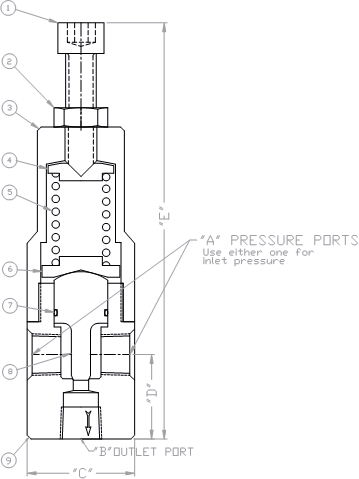This is a multi-port relief valve for gases and liquids with two in-line pressure ports and one outlet port discharging through the bottom of the valve as illustrated. This relief valve or control valve can also be used as a bypass valve or back pressure valve to maintain or control a specified line pressure. Since the outlet pressure port is relatively smaller than the inlet or pressure ports, the effect of any back pressure on the outlet side will have almost no effect on the pressure balance of the valve. Valve should only be used selectively where the materials chosen are compatible with the fluid used and will not cause corrosive buildup or crystallization in the close clearances between the piston and body bore, which could keep the poppet from opening freely. Use only clean, strained, or filtered liquids or gases so that the valve can operate without buildup of debris or solid matter which can cause the valve to malfunction. A strainer with the appropriate material and pressure rating can be purchased from Straval.
Standard metal seated valves as illustrated meet ANSI/FCI Class IV seat leakage standards (0.01% of rated valve capacity, not bubble tight). Soft seat options such as PTFE or Viton are available depending on operating pressures and orifice size.
Special options with tamper-proof wire lock and special sealing caps are also available to contain hazardous materials in case of piston seal wear or seal failure. Panel mounted valves are also available. These valves do not carry the ASME approval stamp or CRN Registration and should not be applied where this requirement must be met. The valves however generally meet or exceed their design criteria.
We now offer some models that meet NACE MR0175. These are not priced on line. Consult factory.
This is a poppet and spring type relief valve where the spring constantly opposes the pressure acting against the poppet which seals off the inlet port from the outlet port at the valve seat. The desired set pressure or relief is achieved by compressing the spring until the spring force is adequate to balance the pressure force acting against the poppet. When the inlet pressure exceeds the set pressure, the poppet will open to relieve the excess pressure. A special valve seat geometry is used when the valve requires a gradual flow control such as for back pressure and bypass service, compared to a quick-opening requirement that is required for relief service.





















































































